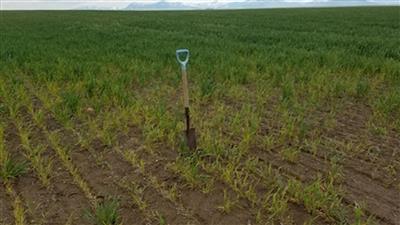Farmers in several Montana counties are experiencing nearly complete yield loss in portions of their fields due to soil acidity (low pH).
Standard top 6-inch soil pH testing may not definitively identify soil acidity problems. Most fields with low pH problem areas also have larger areas with higher pH that buffer the pH value when soil samples submitted to labs are mixed from 6-8 subsamples per field. Also, the lowest pH is generally in the top 2 to 3 inches, not the top 6 inches, further masking the issue. MSU soil scientists have now identified fields in 17 Montana counties with soil pH levels below 5.5, some as low as 3.8. Because many Montana soils have pH levels greater than 7.0, soil acidification received little attention until recently when yield-limiting acidity was identified in Chouteau County.
At pH levels below 5.0, naturally-occurring soil metals (like aluminum and manganese), become more soluble and can stunt root and shoot growth. Young plants in acidic areas are often yellow with club or “witch’s broom” roots (see photos). Substantial yield losses occur at pH levels below 4.5. The most sensitive cereal crops appear to be barley and durum, followed by spring wheat.
The major cause of acidification appears to be ammonium fertilizers, including urea, applied in excess of crop uptake. No-till concentrates the acidity near the surface where fertilizer is applied.
Russell Nemetz talked with MSU Extension Soil Fertility Specialist Clain Jones about this growing problem and options for farmers and ranchers.
Acidity problems usually start in low lying areas of a field (where yield has historically been high), and acidity symptoms spread outward. To identify if you have an acidification problem, look at your top 6-inch soil test. If the pH is consistently above 7.5, it’s unlikely you have a problem. If it is below 6.0, you likely have areas with pH below 5 and have yield-limiting soil acidity.
On fields where standard soil test pH levels in the top 6 inches are below 7.5, scout for yellow seedlings and club roots. To verify that those symptoms are caused by low pH, analyze just the top 2 inches for pH, either with a field pH stick, pH probe, or lab analysis. Soil in the zone at the edge of poor growth areas should also be sampled to determine if the pH is close to toxic on the margins, but do not yet exhibit symptoms. The potential is there for problem areas to grow in size. Areas where pH is 5 to 6 should be managed differently to prevent further acidification.
For additional information on this emerging issue, go to http://landresources.montana.edu/soilfertility and click on Soil Scoops where you will find two documents on soil acidification, or click on Presentations. Please contact Clain Jones, MSU Extension Soil Fertility Specialist (clainj@montana.edu, 994-6076), Dale Krause, Chouteau County CD, (kconsulting@itstriangle.com, 406-622-5627 or 406-622-3659) or MT Salinity Control Association (406-278-3071) if you have any questions.
Source: MSU & Northern Ag Network




